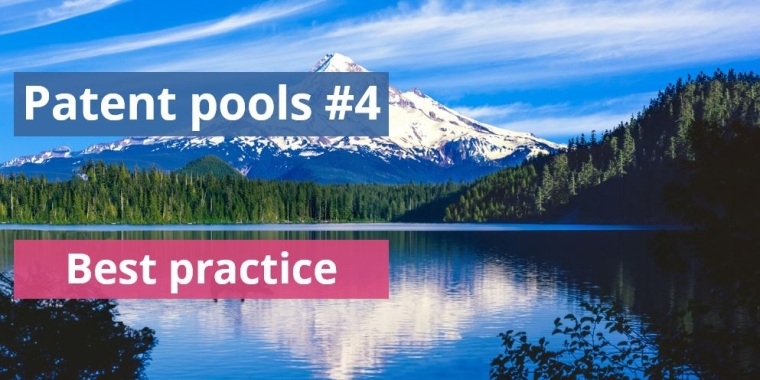Mon 1st Nov 2021
Best practice in standards-based patent pools
Services: Applying for a patent overseas, Board support and consultancy, Innovation capture, International reach, IP licensing, IP portfolio management, IP strategy, Obtaining a patent, Preparing for funding or flotation, Start up or scale up
Sectors: Cleantech and renewables, Electronics and telecoms, Materials science, Mechanical engineering, Software patents
If set up and administered well, patent pools can provide significant benefits for the market, such as reductions in transaction costs, more reasonable aggregate royal-ties, and a better ability to create a level playing field. These benefits can make pa-tent pools an attractive option for standard-based licensing where there are multiple licensors holding SEPs.

Olaf Ungerer, a German and European Patent Attorney in Munich, highlights the features of a successful patent pool and explores example of best practice in the fourth of a series of articles on the subject of patent pools.
Olaf is a member of the German GRUR committee on patents and utility models, which is currently supporting the German Federal Ministry of Justice and Consumer Protection in connection with a contribution paper about a consultation on standards essential patents (SEPs) with the European Commission. The below article is derived from this publicly available contribution paper. For more information, see the ‘SEP Experts Group’ paper Contribution to the Debate on SEPs.
Background
Click here for links to:
- What is a patent pool and how does it operate?
- The pros and cons of standards-based patent pools
- When may a patent pool violate anti-competition rules?
What makes a successful standards-based patent pool?
Experience has shown that standards-based patent pools can be successful where, among other things:
- the pool is able to attract a large enough portion of the SEP holders to offer efficiencies in licensing;
- the pool royalty gains market acceptance among a large segment of implementers; and/or
- a significant number of SEP holders and/or implementers perceive that there is a benefit to licensing patents through the pool versus concluding bilateral licenses.
Arising from the research of the SEP Experts Group, some best practice for the establishment of patent pools has emerged. This includes:
- allocating little or no share of pool revenues to divisional patents or allocating revenues to a limited number of such patents, thereby disincentivizing the opportunistic filing of large numbers of divisional patents in order to increase a licensor’s patent count;
- recognizing that pool patents may have disparate values and giving more weight in royalty allocation methods to higher valued patents;
- introducing fast and low-cost essentiality challenge procedures to incentivize pool licensors and licensees to challenge patents that are believed not to be essential;
- introducing incentives for pool licensors to make one or more of their SEPs available for litigation against unlicensed companies, thereby supporting the pool’s efforts to create a level playing field.
Measuring the success of a patent pool
The success of a patent pool should not be measured only by the licensing revenues, because these are to a large extent determined by the market volume for the products licensed by the pool and the royalty per licensed product.
A more important indicator for the success of a patent pool is the licence coverage of the addressable market, that is the share of the licensable market that is actually licensed. The development of this share is an indicator of how quickly and how well a patent pool can license all potential licensees and create a level playing field in the market.
So far, patent pools have not published any licence coverage figures, although many patent pools publish lists of licensees to demonstrate the success of their program.
Drivers of a successful patent pool
There are various factors that may drive the success of a patent pool, including:
- the patent pool should offer a licensing program that is acceptable to the potential licensees and covers the licensed products for a reasonable royalty;
- the set-up of a patent pool and the key elements of licensing programs administered by a patent pool should be as transparent as possible to facilitate licensing;
- the patent pool should attract both large and small licensors to include a critical mass of SEPs;
- pool governance rules, in particular with regard to voting procedures, should be designed to allow necessary decisions to be made;
- the market for the products licensed by the patent pool should grow more or less in line with the projected growth underlying the business plan of the patent pool;
- the patent pool should be able to make sufficient resources available to license an expected number of potential licensees on a global basis.
How we can help
The team patent attorneys at Page White Farrer includes experts with deep knowledge of a wide range of technologies (see our sector specialisms) including standardized technologies.
We advise inventors and companies on intellectual property strategy, which includes assessing whether licensing via a patent pool or offering patents to a pool would be commercially advantageous. We can also under-take an essentiality evaluation to determine whether a standard essential patent may be entered into a pool.
For more information on patent protection across Europe, please contact our expert attorneys by email to email@pagewhite.com.
This briefing is for general information purposes only and should not be used as a substitute for legal advice relating to your particular circumstances. We can discuss specific issues and facts on an individual basis. Please note that the law may have changed since the day this was first published in October 2021.
Author

